The sixth webinar of «Grounding and lightning protection: issues and problems arising in the design series»
Webinar text. Page 2
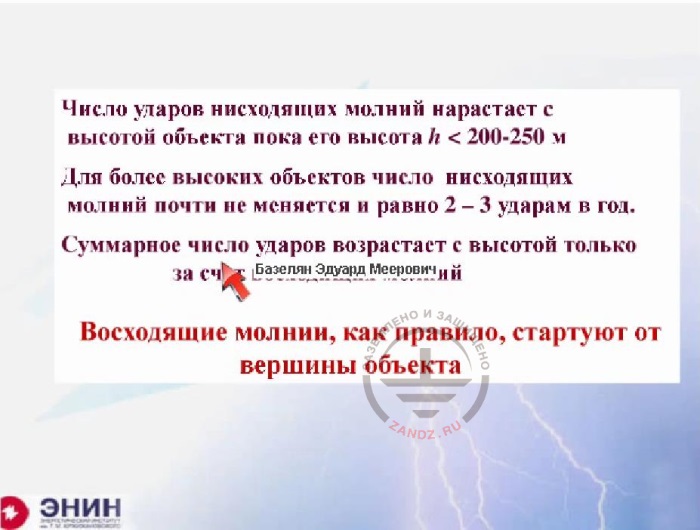
An upward lightning usually starts from the top of a facility
RU - EN
Число нисходящих ударов молнии…-
The number of downward lightning strikes increases with the facility height until it reaches h<200-250 m. For higher facilities, the number of downward lightning strikes almost unchangeable and is 2 to 3 strikes per year. The total amount of strikes increases with height only due to upward lightning strikes.
Восходящие молнии, как правило, стартуют от вершины объекта - Upward lightning strikes generally start from the top of a facility
And if you analyze this relationship, you’ll find something completely strange and not clear. I'm starting to increase the height of the facility. 50 m, 100 m, 150 m, 200 m. If the facility is 200 meters high, then it will attract 2 lightning strikes per year on the average. If I take an object 250 meters high, then there will be the same two lightning strikes, so their number will not increase. 300 meters – and the same 2 lightning strikes, 500 meters – and 2 lightning strikes again. And all the other lightning strikes will start not from the clouds, but from the facility itself and spread not from the cloud towards the ground surface, but from the ground to the cloud. The number of downward lightning strikes coming from the cloud into high-rise buildings is almost independent of their height. The height of the building influences only the number of lightning strikes that start from the object and come to the cloud.
I'll show you a picture of such lightning. This lightning started from the tip of the Ostankino TV Tower and flew up. The upward lightning is branching like a tree towards the side of growth.
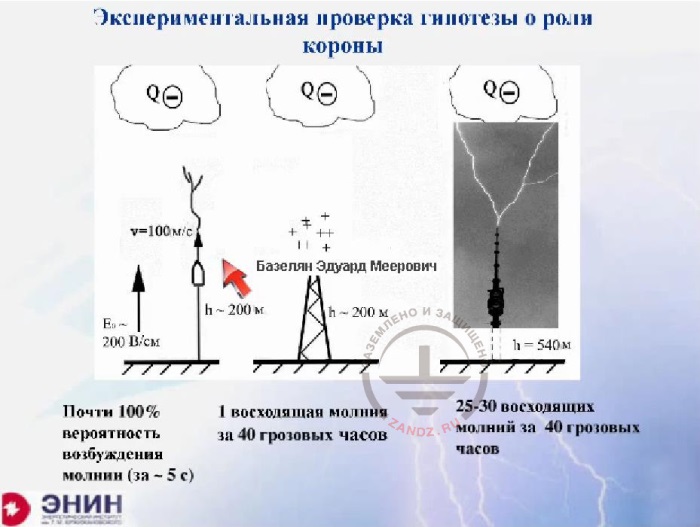
Experimental verification of the hypothesis about the role of the corona
Экспериментальная проверка… - Experimental check of corona influence hypothesis
В/см - V/cm
Почти 100% вероятность… - Almost 100% probability of lightning excitation (in ~5s)
1 восходящая молния… - 1 upward lightning per 40 thunderstorm hours
25-30 восходящий молний… - 25-30 upward lightning strikes per 40 thunderstorm hours
So, out of the 30 lightning strikes I've mentioned, about 28 to 27 strikes are upwards-type that bombard the cloud starting from the top of the facility. That's what the situation with high-rise buildings.

High air terminals
RU - EN
Высотные молниеотводы - High air terminals
- представлены только в РД 34.21.122-87 - specified only in RD 34.21.122-87
- в инструкции СО-153-34.21.122-2003… - In SO 153-34.21.122-2003, the lightning rod height is up to 150 m
1.2. Зона защиты одиночных… 1.2. Protection zone for stand-alone lightning rods with a height of 150
При h=600 m радиус зоны А по RD 34.21.122-87 отрицательный? - Ah h=600 m, A zone radius under RD 34.21.122-87 is negative???
Как в реальности? - What’s in reality?
And now let's look at the protection zones specified in the RD 34 and which, as I have already said, are not very reasonable. I've taken a page from RD 34 document and now I’m showing it to you. This is a formula for the A zone calculation and this is a formula for B zone calculation. If I take the formula from A zone, put a facility 600 meter high in this zone, and calculate the protection radius for the zone, then I get a negative value. You can see it yourself. The protection zone radius will be negative. This is a gross negligence by the authors of these regulations because you'll never understand what to do with the negative protection zone.
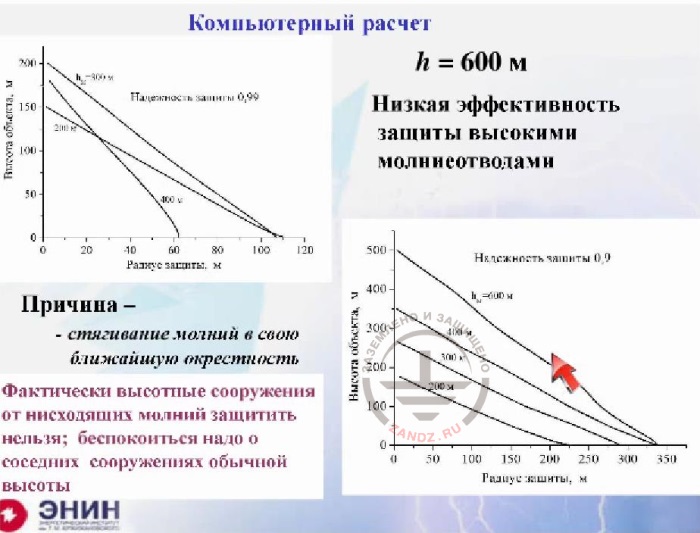
Software calculations
RU - EN
Компьютерный расчет - Software calculation
Высота объекта, м - Facility height, m
Надежность защиты 0.99 - Protection reliability, m
Радиус защиты, м - Protection radius, m
Причина – стягивание молний …. - The reason is lightning attraction in the neighborhood
To understand the matter, we've recalculated the protection zones before this webinar to see how they depend on the altitude. The software calculation shows the two protection zones. One protection zone has a reliability of 0.99, but it's something similar to zone A and the second protection zone has a reliability of 0.9. This resembles zone B. Now see what happens. I have a border of a protection zone provided by a lightning rod 200 meters high. Here it is. And this is the border of a zone provided by a lightning rod 300 meters high. Look at this. The radius at the surface level hasn't changed at all. The lightning rod height doesn't change the protective effect. And this is the protection radius of the lightning rod 400 meters high. Its protection zone radius appears to be smaller. Look, the radius was almost 120 meters, and now it is 60 meters. You'll have almost the same picture with B protection zone as well. What conclusion can I draw from that? There are two conclusions, actually. The first one is this. It is very difficult to protect the upper floors of high-rise buildings, as there is no protection from a downward lightning strike for such facilities. They just do not exist. As for the structures on the ground surface, it appears that a high-rise building not just don't protect anything around it but seems to provide a kind of reverse effect. Because there is no protective effect from the lightning rod at all. Imagine a tower having a height of 500 m, and the protection radius at the ground level is 60 m. It is not a protection in any way. That is because the following thing happens.
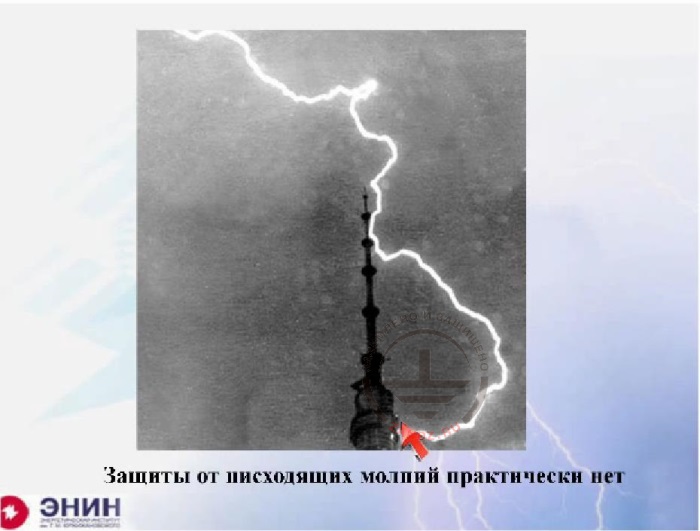
There is virtually no protection against a downward lightning strike
RU - EN
Защиты от нисходящий молний практически нет - Protection from downward lightning strikes virtually doesn’t exist
You'd better understand this. But before you understand it, I still want to show you a picture that proves it. Look, it's the Ostankino TV Tower. The height from this point to that point is 202 m. The lightning strike just missed the tip of the tower and struck into the section under the Seventh Heaven Restaurant. That is, the surfaces of the high-rise buildings do not protect even themselves. That's the situation. The reliability of high-rise building protection is virtually zero, really zero.
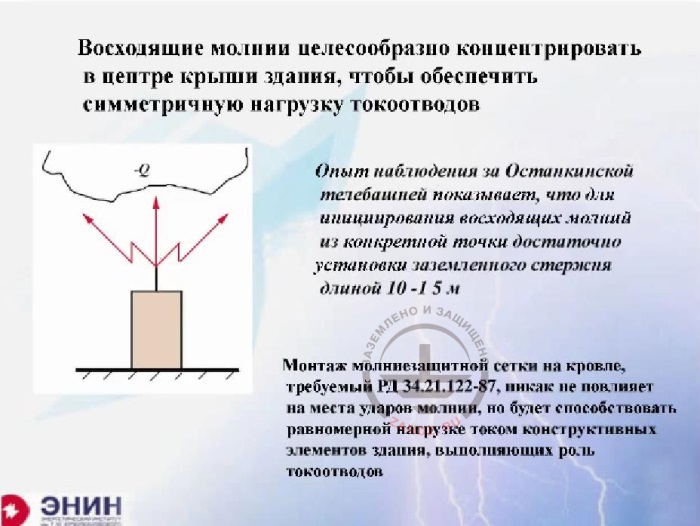
It is advisable to concentrate upward lightning strikes
RU - EN
Восходящие молнии целесообразно…
It is reasonable to concentrate upward lightning strikes in the roof center to ensure symmetric down conductor load
Опыт наблюдения за Останскинской телебашней показывает..
The experience of observations over the Ostankino TV Tower shows that to initiate an upward lightning strike from a specific point, it is enough to install a lightning rod 10-15 m long.
Монтаж молниезащитной сетки на кровле…
The installation of lightning protection mesh cage on the roofing required by RD 34.21.122-87 does not affect the lightning strike point in any way, but will facilitate an even distribution of the current throughout the structural elements of the building that act as down conductors.
And the only rescue we have is this. Speaking of high-rise buildings, it is still an overwhelming number of discharges that strike into them. These are lightning strikes that start at the top of these buildings and go up. So that the upward lightning could start from any one point (and they start from the highest point), it is enough to install a very low lightning rod on such building, for example, a 10-meter rod. This is quite enough. Then all the lightning strikes that go up will start from this low lightning rod. The Ostankino Tower shows the way it is. That is, it is easy to protect the structure against the upward lightning, but it is very difficult or almost impossible to protect it against a lightning strike going down from the cloud.
The first questions and answers session
- Nadezhda, do we have questions already?
- Yes. Good afternoon! There was a question in the beginning of your presentation. It is about the accessible roofing. What should you do, for example, if a shopping center building has an outdoor cafe on the rooftop? The building has a height of 20 meters and an area of 2,000 square meters.
- Let’s put it this way. The building is 20 meters high, so it cannot be called a high-rise structure even in the Big Dirt village. That is, it's still an ordinary structure, and things I've said about high-rise buildings have nothing to do with it. But it is necessary to protect the cafe on the roof. You need to protect it on the roof of even such a low building. I'll talk about it in the end. I am sure that I will be able to answer this question in the end. And I shall advise actions to protect people there. But if we talk about a high-rise building, then its upper floors will not be protected from the lightning going down from the cloud, whatever you do on the roof. The only protection that you can provide is to protect the floors with a mesh cage placed not on the roof but right on the side walls if this is necessary. This can be done if, for example, the building is residential or an office center. Different structures can play the role of the metal mesh cage. This will be discussed further on.
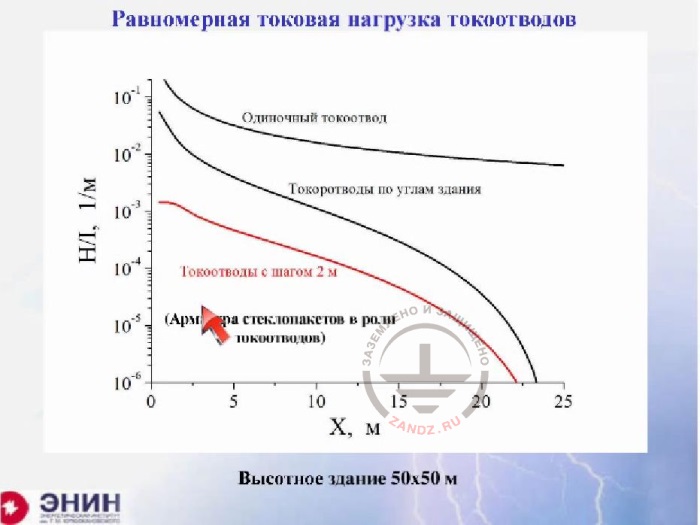
Uniform current load of down conductors
RU - EN
Равномерная токовая нагрузка токоотводов - Even current load distribution over down conductors
Одиночный токоотвод - Single down conductor
Токоотводы по углам здания - Down conductors at the angles of the building
Токоотводы с шагом 2 м - Down conductors with a step of 2 m
(Арматура стеклопакетов в роли токоотводов) - (Double glazing window frames are used as down conductors)
Высотное здание 50х50 м - High-rise building 50x50 m
Now there's another thing. Both upward and downward lightning strikes pass the current through the building. And with high-rise buildings, this happens quite often. The Ostankino Tower attracts 30 lightning strikes per year. Today, we have office buildings 300 to 350 meters high in the center of Moscow. The number of the lightning current impacts during the storm season is somewhere at the level of 15. That is, the exposure is very frequent. You see? And as the exposure is very frequent, the current must be diverted into the soil so as not to excite large electromagnetic interferences in the electrical equipment inside a building. The equipment includes microprocessor appliances, computers, and networking equipment. What can be done here? The current is an inevitable thing. Like it or not, it will flow. The example I'll show here is as follows. We have a high-rise building with a base area of 50 * 50 meters. I was stupid enough to install a single down conductor. The magnetic field intensity depending on the distance of this down conductor. Look, the magnetic field is decreasing and it is very high, about 1/10 A m. This is a strong field that will cause severe interference. Of course such a thing cannot be allowed. What can be done? There is only one solution. You need to distribute this current into several down conductors. The second curve is like this. I've dropped the down conductors along the four corners of the building. Look, I have a logarithmic scale here, so I reduced the magnetic field by about one order of magnitude due to the four down conductors. The magnetic field has decreased even at close distances by one order of magnitude, and further on it decreased even more, do you see it? Thus, increasing the number of down conductors is quite a good way to reduce magnetic interferences in the electrical circuits inside high-rise buildings. Now I'm doing the following, and this is a completely wild thing, really. I'm showing down conductors installed at a distance of only two meters one from another. As you see, in this case, the interference decreases more than 100-fold, even near the down conductor. The question is where do you find a fool who dares designing down conductors with a step of 2 meters? You know, this is done almost for free in most high-rise buildings. How? What is a high-rise building? It is a reinforced concrete frame - sometimes prefabricated, but more often cast in-situ, with walls hung on it. The walls do not bear any mechanical loads, as it's just a protection from the cold and the noise, and these are windows to pass the light inside. That is the side walls of high-rise buildings are made from double glazing in the vast majority of cases. And these double-glazed windows have metal reinforcement frames. And as a rule, the metal frames are made from duralumin, which is allowed today as a conductor to divert the lightning current. You just have to connect the windows to each other from top to bottom, and this connection will occur automatically because they will be hung on embedded parts of the ceiling. So you'll get the system of down conductors with a step equal to the width of the double glazing. That's where my 2 meters came from. You see? That is the down conductors turn out to emerge themselves. And in this case, electromagnetic interference are weakened to such an extent that computer circuits inside the building will not even require the installation of any surge protection devices. SPDs will not be required. There is another very important point here. And this is the following. I've said that it is necessary to protect upper floors with the mesh cage to prevent the lightning strike from coming inside the building. The point is that this mesh cage also emerges by itself thanks to the double glazing. You see? You have everything, and come up with additional lightning protection on the upper floors is not required, and the lower it is not necessary. Once again, Nadezhda, are there any questions?
- Yes. Dear colleagues, please ask questions if you have any of them left so that we can proceed to the next part. At the moment, there is only a question about the mesh cage you've mentioned. Is it possible to cast it into the concrete? And will it work in this case?
- I'd better wait until the end, OK? I will not answer this question now.
- I guess no.
<< Previous Page
Slides from 1 to 10
Next Page >>
Slides 18 to 22 and the Q&A session
Related Articles:



